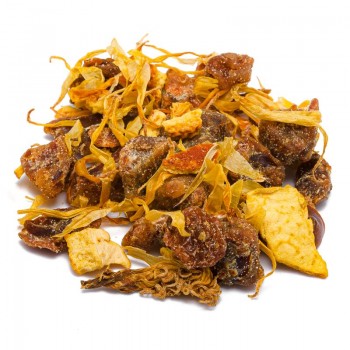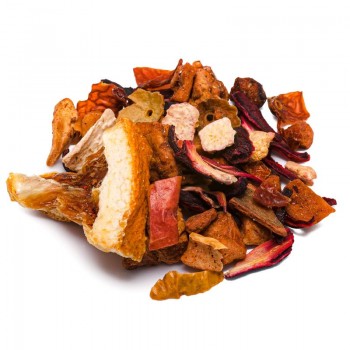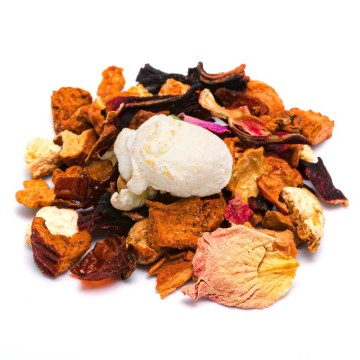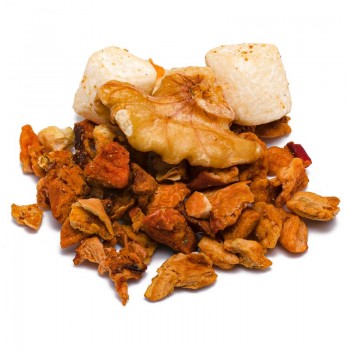This super aromatic blend combines several exotic flavors and allows you a unique experience on the palate and aromas. Tropical fruit combines with the aromas of pomegranate and grapes, the floral touch of hibiscus and rose petals, up to the earthy notes that emerge from the vegetables. The combination creates a refreshing and sweet infusion, perfect cold to quench thirst in summer. It is excellent warm to unleash its potential all year round. Juicy mango and pungent pomegranate are the protagonists of an infusion that evokes summer fruit and a tropical journey of the senses.
Pomegranate and mango infusion: properties and benefits
Symbol of prosperity and abundance, the pomegranate is a concentrate of well-being capable of providing vitamins and mineral salts, antioxidants and compounds useful to our body. Mango is a concentrate of beneficial substances, as it contains vitamins A, B and C, useful for our immune system and metabolism. Together with other phenolic compounds from the other ingredients, it creates a valuable antioxidant blend; in particular, enhanced by the properties of hibiscus and rose petals. Other fruits such as pomegranate, grapes, pineapple and papaya also provide precious vitamins and minerals for the body. As a source of antioxidants, a fruit infusion helps counteract cell damage due to free radicals; an action that also counteracts aging. In addition to the dose of vitamins, the mineral salts including potassium, calcium and magnesium create a resource in the infusion as a natural energy supplement, anti-tiredness.
Thanks to the presence of mango, apple, pineapple and papaya, the infusion stimulates correct digestion with regular intestinal movement; thus reducing the risk of constipation, diarrhea, bloating and other gastrointestinal problems. It can reduce irritations due to digestion, also thanks to the contribution of carrot and lemon. The pomegranate and mango infusion nourishes good bacteria and counteracts those harmful to digestion. By taking this infusion you can also obtain a satiating and fruity flavor that helps curb the appetite during slimming diets. It helps hydration and purification, also stimulating the metabolism. Thanks to its compounds that fight free radicals, the infusion is also healthy for the skin and for the well-being of the oral cavity.
Origins and history of cultivation
Mango is one of the most important and cultivated fruits of the tropical world, where it comes from. The mango tree is thought to derive from the territories of southern Asia (Myanmar and Assam), and numerous varieties have been developed over the centuries. The fruit is very linked to the religious and popular ceremonies of India, and according to tradition a mango grove was given to Buddha so that he could rest under his shade. The name mango probably derives from the Malay manna, which the Portuguese translated as manga when they arrived in Kerala (1498) in search of spices. The difficulty of transporting mango seeds (they last for a short time) led to its introduction elsewhere only in the eighteenth century, when it was planted in Brazil. Mango is now cultivated in most of the warmer tropical and subtropical areas, especially in southern Asia. There are now two main variations, the Indian mango and the Southeast Asian mando. Even today, the infusion of mango leaves is consumed, a very popular drink in Asia and India.
The pomegranate is one of the oldest fruits known to humans. It is already mentioned in the Bible, the Koran, Buddhist and Chinese traditions. Based on evidence, the pomegranate is thought to have been introduced into the human diet around 5000-4000 years ago. The modern plant derives from the wild pomegranate, which grew in Central Asia, in the areas of ancient Persia (Iran) and Turkmenistan, up to northern India (Himalaya). The fruit was known and appreciated for its nutritional and medicinal values, in addition to the ornamental use of the plant. Over time, different varieties have developed from the original genus, Punica, to the cultivated form of the pomegranate. Today the pomegranate tree is cultivated in several tropical and subtropical regions of the Northern Hemisphere, as it is easily adaptable to various climatic and soil conditions. The best quality fruits appear to be those that grow in arid regions.
Fruits and flowers
The mango fruit comes from the evergreen plant Mangifera indica, part of the Anacardiaceae family. The tree often reaches 15 meters in height and lives for many years. It shows long leaves and small, pink and fragrant flowers. The fruits vary greatly in size and characterrhistics: some varieties are colored with shades of red and yellow, while others are dull green. The fruit has a single large flattened seed and juicy yellow-orange to orange pulp.
The Punica granatum L. tree is the source of pomegranate fruits. It is a tree and grows mainly in temperate climate. The fruit of the pomegranate (also called pomegranate) is actually a fleshy berry, showing a thick skin – when ripe the fruit is yellow-green. Inside the fruit there are many fleshy and juicy seeds, which represent the most exploited part at an edible level. The differences between the varieties determine the acidity of the fruits, considered sour, sweet or sour-sweet.
The Rose is a plant of the Rosaceae family, native to Asia. There are over three hundred species and thousands of rose cultivars, always in the form of a perennial plant. It can appear as an erect shrub or as a climbing plant, with or without thorns. Depending on the variety, the flowers change in shape, size and color from white to yellow and dark red.
The apple plant is the Malus domestica tree of the Rosaceae family. It is a plant native to Asia, now cultivated throughout the planet. The fruits vary in color and consistency, due to the many varieties, from yellow to green and red apples.
Ananas comosus is a plant of the Bromeliaceae family. It is not very tall and grows best on well-drained soil, exposed to the sun. The fruits have a shape that resembles a pine cone, and are formed by the union of the flowers and berries of the plant, to form a single fruit.
Carrots derive from the Daucus carota plant, of the Apiaceae family. It is one of the most common vegetables, the root of which is used in cooking. It shows a green stem and fine leaves, and the typical orange root. The plant is widespread in Europe, Asia and North Africa.
The hibiscus plant is Hibiscus sabdariffa, of the Malvaceae family. It grows in tropical and subtropical regions around the world. The leaves are consumed as a vegetable, the calyx and flowers are used as flavourings, colorings and for the preparation of hibiscus tea.
The grape comes from the Vitis vinifera L. plant, a genus of plants belonging to the Vitaceae family. It is a vigorous climber, which can easily cover walls and surfaces. It displays large leaves and tiny green flowers. The famous fruits are globose clusters, different depending on the variety of the vine.
Beetroot (Beta vulgaris) is a plant of the Amaranthaceae family. A fast growing vegetable, which can be grown anywhere. Of all the edible parts, the roots are widely exploited. The best-known root beets are red, but there are golden and striped varieties.
The Carica papaya is a tree of the Caricaceae family. It shows little branching, and in some cases reaches up to 10 meters in height, with a warm or temperate temperature. The color of the fruits can have various shades between green, yellow, orange or pink. They can reach up to 30 cm and weigh 9 kg.
The kiwi fruit comes from a climbing vine that belongs to the Actinidia genus and the Actinidiaceae family. There are about fifty species of this genus, with a wide variety of fruits, which are berries. The two main varieties are green and yellow kiwi.
Lemons grow from the evergreen tree Citrus limon, of the Rutaceae family. They grow best in tropical climates characterized by heat and humidity, while they are very sensitive to cold. There are many modern varieties, over 20 different types of lemons grown all over the world.
Nutritional values of pomegranate and mango infusion
The infusion blend provides a concentration of minerals (including potassium, calcium and magnesium), antioxidants and vitamins (A, B, C).
How to use the ingredients in the infusion The infusion is obtained by placing approximately 3-5 grams of the pomegranate and mango mixture with water at 100 °C in a cup (250 ml). Leave to infuse for 10 to 12 minutes before drinking. Add honey or sugar, if desired.
Pomegranate and mango infusion: side effects and contraindications
To obtain the benefits of herbal tea it is necessary to respect the recommended doses and not exceed its consumption for too long periods. Excessive intake can cause constipation, diarrhea, stomach acidity and nausea. An evaluation of all ingredients is recommended for those suffering from food allergies. Caution advised for pregnant or breastfeeding women.

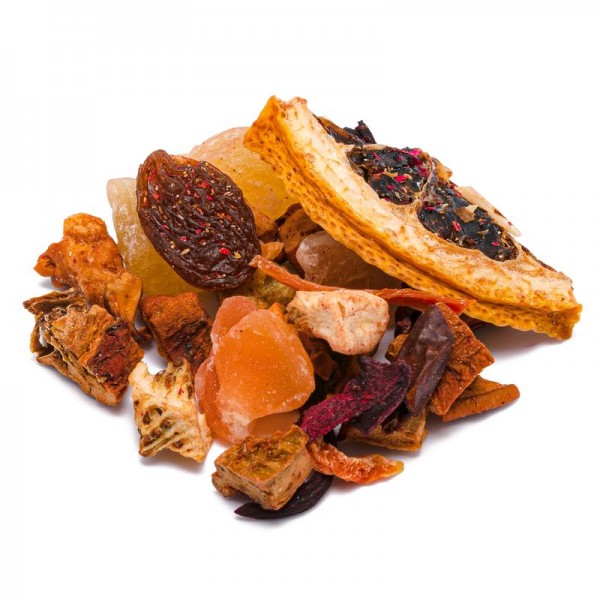







 No reward points for this product.
No reward points for this product.
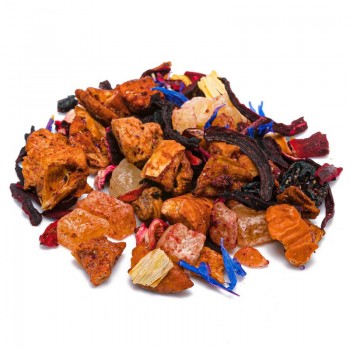
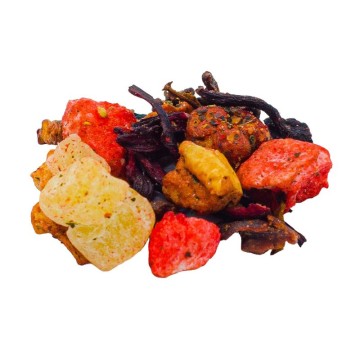
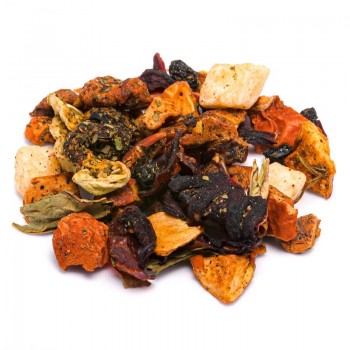
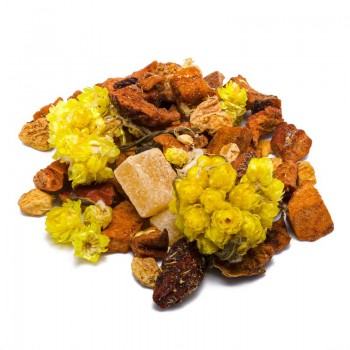
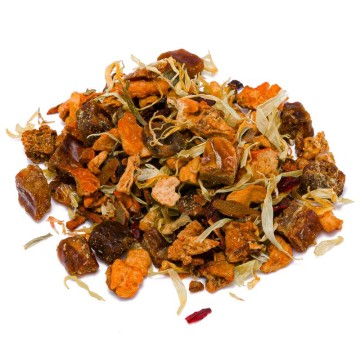
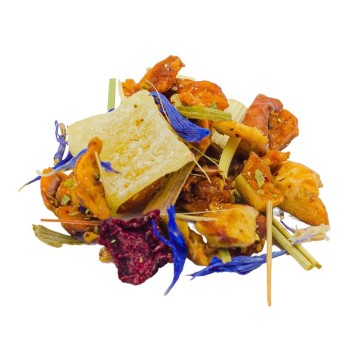

![infuso pesca e vaniglia [Natura d'Oriente]](https://www.naturadoriente.com/3538-home_default/infused-peach-vanilla.jpg)

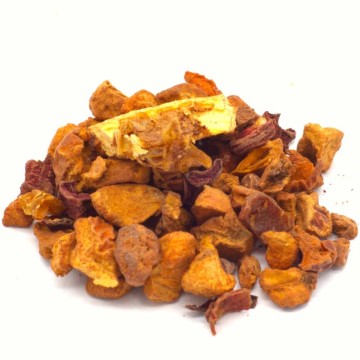
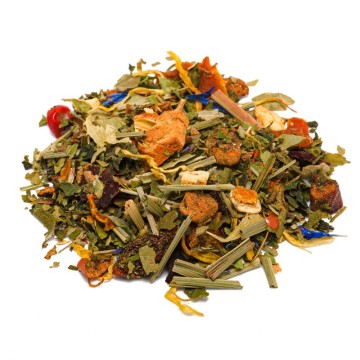
![infuso frutti rossi [Natura d'Oriente]](https://www.naturadoriente.com/3542-home_default/infusion-of-red-fruits.jpg)
